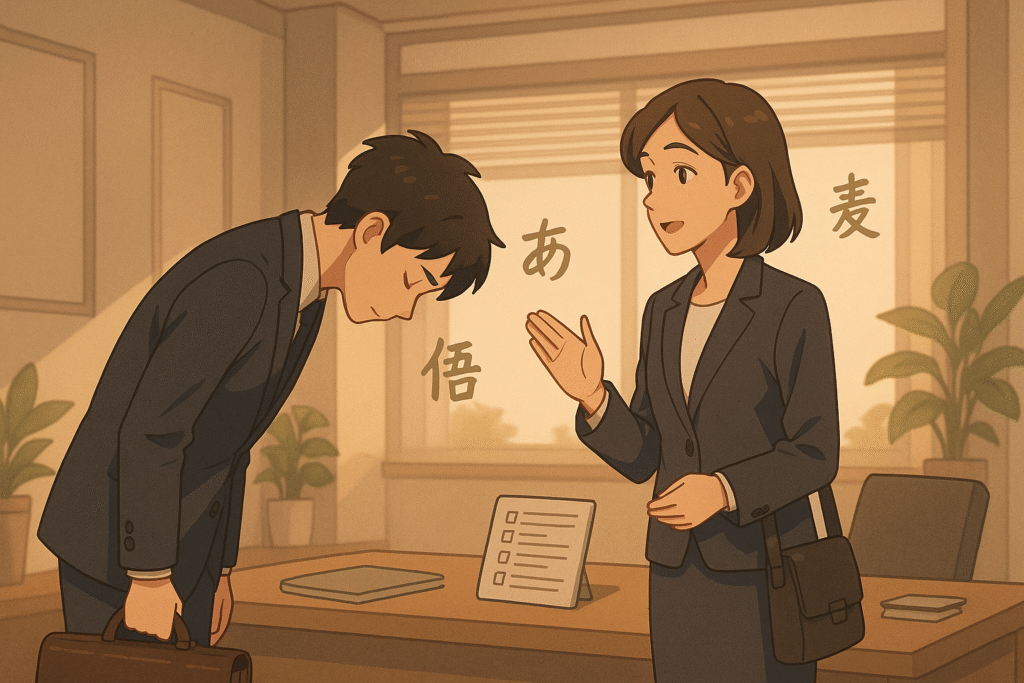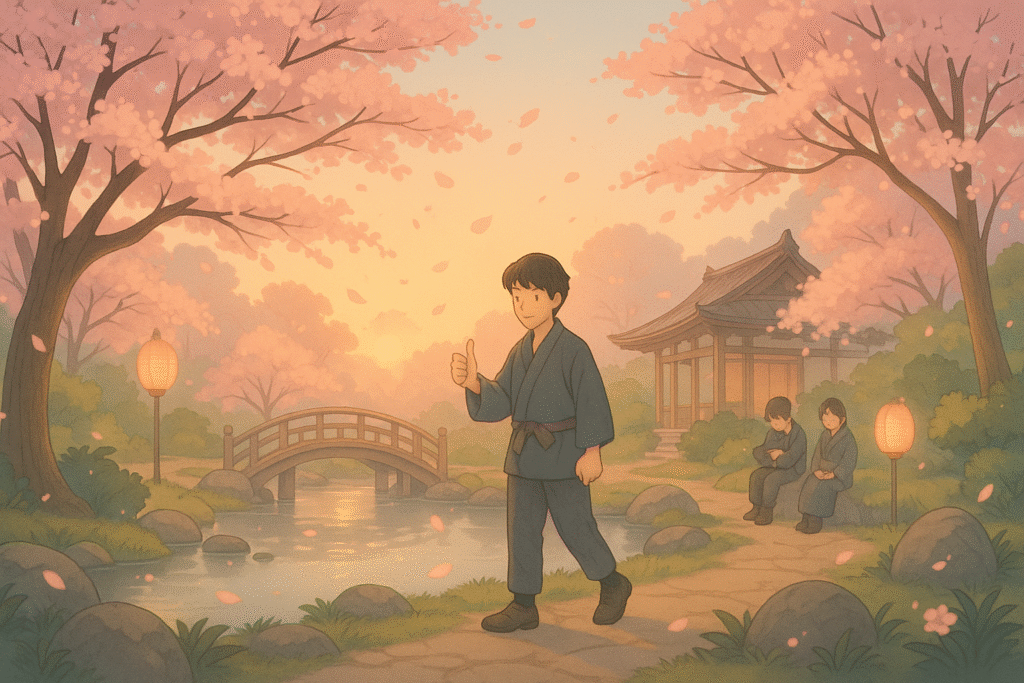Have you ever found yourself in a situation where you’re meeting someone new in Japan and freezing up because you’re unsure whether to say “douzo yoroshiku” or “hajimemashite” first? This common confusion affects many Japanese language learners, especially those preparing for the JLPT N5 exam. The difference between douzo yoroshiku vs hajimemashite isn’t just about vocabulary—it’s about understanding the cultural flow of Japanese introductions.
The First Impression: Understanding Japanese Greetings
In Japanese culture, first impressions carry significant weight. Using the correct greeting phrases doesn’t just demonstrate language proficiency; it shows respect for Japanese social customs. The phrases “douzo yoroshiku” and “hajimemashite” are both essential parts of introductions, but they serve different purposes within the conversation flow.
When comparing douzo yoroshiku vs hajimemashite, it’s important to understand that they’re not interchangeable options but rather complementary phrases used at different moments during an introduction.
What Does “Hajimemashite” Really Mean?
“Hajimemashite” (はじめまして) is derived from the verb “hajimeru” (はじめる), which means “to begin.” When you say “hajimemashite,” you’re essentially saying “We are meeting for the first time.” This phrase is the perfect conversation opener when encountering someone new.
When to Use “Hajimemashite”:
- At the very beginning of your first interaction with someone
- Before stating your name
- Only once per person (since you can only meet someone for the first time once)
Example in action:
- Japanese: はじめまして、山田です。
- Romaji: Hajimemashite, Yamada desu.
- English: “Nice to meet you. I am Yamada.”
The Meaning Behind “Douzo Yoroshiku”
“Douzo yoroshiku” (どうぞよろしく) or its more complete form “douzo yoroshiku onegaishimasu” (どうぞよろしくお願いします) carries a nuanced meaning that doesn’t translate perfectly into English. It combines elements of “please treat me well,” “I look forward to our relationship,” and “pleased to meet you.”
In our douzo yoroshiku vs hajimemashite comparison, this phrase comes after you’ve stated your name and follows “hajimemashite” in the natural flow of Japanese introductions.
When to Use “Douzo Yoroshiku”:
- After stating your name during introductions
- When concluding an initial meeting
- When requesting cooperation or assistance from someone
Example in action:
- Japanese: 田中です。どうぞよろしくお願いします。
- Romaji: Tanaka desu. Douzo yoroshiku onegaishimasu.
- English: “I’m Tanaka. I look forward to our relationship.”
The Perfect Introduction: Putting It All Together
When comparing douzo yoroshiku vs hajimemashite in practice, here’s the standard flow of a proper Japanese introduction:
- Begin with “Hajimemashite” (We are meeting for the first time)
- State your name (typically family name for formal situations)
- End with “Douzo yoroshiku” (Looking forward to our relationship)
Complete example:
- Japanese: はじめまして、鈴木です。どうぞよろしくお願いします。
- Romaji: Hajimemashite, Suzuki desu. Douzo yoroshiku onegaishimasu.
- English: “Nice to meet you. I am Suzuki. I look forward to working with you.”
Want to explore Japan’s culture?
Discover Japan’s rich culture, traditions, and hidden gems with our expertly crafted guides. Get insider tips on travel, food, and history. All for free!
Cultural Nuances: Beyond the Words
Understanding douzo yoroshiku vs hajimemashite isn’t complete without acknowledging the non-verbal aspects of Japanese introductions. As we explored in our article about saying “shut up” in Japanese, Japanese communication relies heavily on context and non-verbal cues.
The Bow (Ojigi)
In Japan, introductions are typically accompanied by a bow rather than a handshake. The depth and duration of your bow communicate respect, with deeper bows showing greater deference.
When saying “hajimemashite” and “douzo yoroshiku,” a 15-degree bow is generally appropriate among peers. For more formal situations, especially when meeting seniors or superiors, a deeper 30-degree bow may be appropriate.
Common Mistakes: What Not to Do
When navigating douzo yoroshiku vs hajimemashite, language learners often make these mistakes:
- Using only one phrase (both are needed for a complete introduction)
- Reversing the order (always start with “hajimemashite”)
- Overusing “watashi wa” (Japanese often omit personal pronouns)
- Forgetting to bow while speaking these phrases
Context Matters: Formal vs. Casual Situations
The douzo yoroshiku vs hajimemashite dynamic shifts slightly depending on formality. In very casual situations among young people, you might hear abbreviated versions:
- Casual “douzo yoroshiku” → “yoroshiku” (よろしく)
- Super casual (among peers only) → “yoroshiku ne” (よろしくね)
For business or formal situations, the complete “douzo yoroshiku onegaishimasu” (どうぞよろしくお願いします) is most appropriate, as we discussed in our article about expressing strength in Japanese where mastering formal language is considered a sign of personal strength.
Learning Tip: Mastering These Phrases for JLPT N5
Both “douzo yoroshiku” and “hajimemashite” appear frequently in the JLPT N5 exam. To master these phrases along with other essential Japanese conversation basics, our JLPT N5 Study Guide provides comprehensive practice exercises and situational examples.
The key to remembering douzo yoroshiku vs hajimemashite is simple: “hajimemashite” contains “hajime” (beginning), so it comes at the beginning of the introduction.
Expanding Your Japanese Greeting Knowledge
Once you’ve mastered the douzo yoroshiku vs hajimemashite distinction, you can expand your Japanese greeting repertoire with these related phrases:
- Ohayou gozaimasu (おはようございます) – Good morning
- Konnichiwa (こんにちは) – Good afternoon/Hello
- Konbanwa (こんばんは) – Good evening
- Sayounara (さようなら) – Goodbye (for long partings, as explored in our article about sayonara in Japanese)
Quick Q&A: Your Douzo Yoroshiku vs Hajimemashite Questions Answered
Q: Can I use “douzo yoroshiku” without saying “hajimemashite” first? A: Yes, but only if you’ve already been introduced by someone else. Otherwise, start with “hajimemashite” for a complete introduction.
Q: What’s the simplest way to remember the difference between these phrases? A: “Hajimemashite” is for first meetings, while “douzo yoroshiku” expresses goodwill for your future relationship.
Q: How formal should my bow be when saying these phrases? A: A 15-degree bow works for most casual to semi-formal situations. Increase to 30 degrees for business or very formal contexts.
Q: Can I use these phrases in emails or text messages? A: Yes, “hajimemashite” and “douzo yoroshiku” are both commonly used in written communications when making first contact.
Q: Do I need to say my full name or just my family name? A: In formal situations, use your family name. Among peers or casual settings, given names are acceptable.
Conclusion: Mastering Japanese First Impressions
The difference between douzo yoroshiku vs hajimemashite is that “hajimemashite” acknowledges the first meeting, while “douzo yoroshiku” expresses hope for a positive future relationship. When used together in the correct order, these phrases form the foundation of proper Japanese introductions.
By mastering these essential greeting phrases, you’ll not only improve your language skills but also demonstrate cultural awareness that Japanese people deeply appreciate. Remember that in Japanese culture, the way you introduce yourself sets the tone for all future interactions.
Ready to take your Japanese language journey further? Our JLPT N5 Study Guide covers these greeting essentials plus everything else you need to pass your first Japanese proficiency test with confidence.
Have you had experiences using these phrases in real-life situations? We’d love to hear your stories in the comments below!
Love Japan? Stay in the Loop!
Get the best of Japan straight to your inbox: language, culture & travel insights!




